Exxon and Chevron just lost their most important excuse for new oil drilling
Time is up for any new oil and gas drilling worldwide, according to a major report from the International Energy Agency on May 18. The report lays out what IEA believes will be necessary to avert global warming of greater than 1.5 degrees Celsius above pre-industrial levels, the just-shy-of-catastrophe ceiling enshrined in the Paris climate agreement. The pathway to that goal is “narrow but still achievable,” the report says—but only if “there are no new oil and gas fields approved for development, and no new coal mines or mine extensions” beyond 2021.


Time is up for any new oil and gas drilling worldwide, according to a major report from the International Energy Agency on May 18. The report lays out what IEA believes will be necessary to avert global warming of greater than 1.5 degrees Celsius above pre-industrial levels, the just-shy-of-catastrophe ceiling enshrined in the Paris climate agreement. The pathway to that goal is “narrow but still achievable,” the report says—but only if “there are no new oil and gas fields approved for development, and no new coal mines or mine extensions” beyond 2021.
To be clear, the report still leaves considerable room for continued fossil fuel production from existing fields—by 2050, in the IEA scenario, fossil fuels still provide one-fifth of global energy consumption (down from four-fifths today), mostly in the production of plastics and in facilities outfitted with carbon capture systems. Still, that conclusion is a major pivot for IEA, a Paris-based international research organization whose previous reports had sanctioned a much bigger role for new oil and gas development as a way to meet the world’s growing demand for energy.
That poses a big problem for major oil companies, which had cited the IEA’s calculations as an excuse to stick to their traditional business model despite the mounting urgency of the climate crisis. Exxon, for example, in slides presented to shareholders in March ahead of its annual meeting on May 26, cited an earlier IEA report that calls for an additional 10 million barrels of oil per day to hit the market by 2026, and beyond—much of which, the IEA now says, would be incompatible with a 1.5 C world.
“The industry has used IEA scenarios as a shield to justify its continued investment in oil and gas for a very long time, so this switch is quite momentous,” said Andrew Logan, senior director for oil and gas at the sustainable investment group Ceres. “It’s going to be an interesting reality check for companies, but also for investors, and will put engagement in very stark terms.”
Notably, the IEA scenario doesn’t allow room for nature-based carbon offset credits, like those derived from forest conservation projects. Offsets are key to the long-term “net zero” goals of most fossil fuel companies, because they offer a way to continue drilling while ostensibly making progress toward decarbonization. But the global offset market is plagued with shoddy accounting and greenwashing. Disallowing offsets makes the IEA scenario more scientifically credible, but also makes it considerably harder to achieve, and will increase pressure on oil companies from shareholders and governments to limit their reliance on offsets.
The easiest way to reach the goal would be a high global price on carbon that ratchets up over time, the report says. In the absence of that, it calls for $5 trillion in annual global investment in the energy sector to speed up the commercialization of renewables, carbon capture, and other clean energy systems so that they can outcompete fossil fuels fair and square.
After years of egging oil companies on, why the sudden pivot in IEA’s messaging? The IEA itself didn’t provide any explanation for the change in its report. Logan says the answer is simple: political cover from US president Joe Biden.
“The science isn’t new, but the political reality around a net-zero transition is,” Logan said. “The IEA exists largely to serve its members—rich, energy consuming nations. Until the US committed to a net-zero pathway earlier this year, the IEA would have been in conflict with its biggest member if it had taken the sort of stance that it did today.”